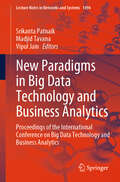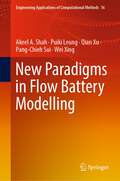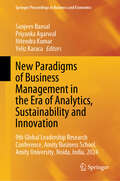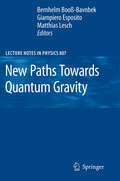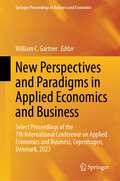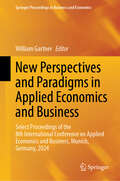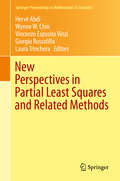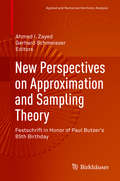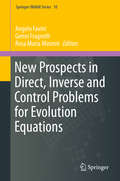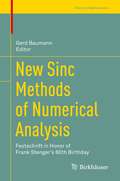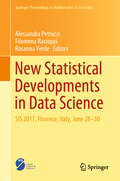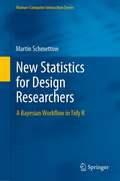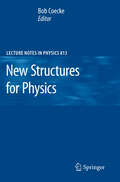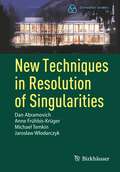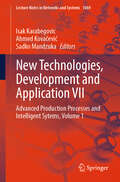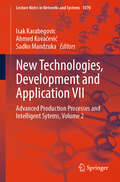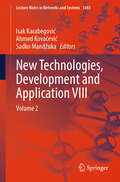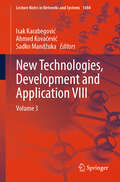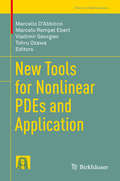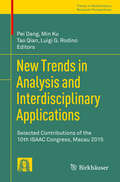- Table View
- List View
New Paradigms in Big Data Technology and Business Analytics: Proceedings of the International Conference on Big Data Technology and Business Analytics (Lecture Notes in Networks and Systems #1494)
by Vipul Jain Madjid Tavana Srikanta Patnaik&“New Paradigms in Big Data Technology and Business Analytics&” emphasize the integration of Big Data Technology and Business Analytics enables organizations to transform vast volumes of data into strategic insights, driving smarter decisions, operational efficiency, and innovative growth. This volume presents a comprehensive exploration of the evolving landscape of Big Data Technology and Business Analytics, showcasing transformative approaches that are reshaping industries and research alike. It highlights the integration of advanced tools such as artificial intelligence, machine learning, data mining, and cloud infrastructure to drive intelligent decision-making and operational efficiency. Focusing on both theoretical frameworks and real-world case studies, this book explores into five essential domains: Big Data Infrastructure and Technologies, Data Mining and Machine Learning, Big Data Applications and Case Studies, Business Intelligence and Decision Support, and Data Governance and Ethics. By merging theoretical knowledge with practical applications, this book equips educators, researchers, practitioners, and students with actionable insights into how data-driven strategies can unlock sustainable growth and innovation across sectors. With a forward-thinking vision, it addresses key issues like data privacy, algorithmic fairness, and strategic deployment of analytics in diverse environments. By blending emerging technologies with practical applications, this book serves as a roadmap for anyone aiming to harness the full potential of big data to reshape modern business and society.
New Paradigms in Flow Battery Modelling (Engineering Applications of Computational Methods #16)
by Qian Xu Pang-Chieh Sui Akeel A. Shah Puiki Leung Wei XingThis book provides a comprehensive review of the latest modelling developments in flow batteries, as well as some new results and insights. Flow batteries have long been considered the most flexible answer to grid scale energy storage, and modelling is a key component in their development. Recent modelling has moved beyond macroscopic methods, towards mesoscopic and smaller scales to select materials and design components. This is important for both fundamental understanding and the design of new electrode, catalyst and electrolyte materials. There has also been a recent explosion in interest in machine learning for electrochemical energy technologies. The scope of the book includes these latest developments and is focused on advanced techniques, rather than traditional modelling paradigms. The aim of this book is to introduce these concepts and methods to flow battery researcher, but the book would have a much broader appeal since these methods also employed in other battery and fuel cell systems and far beyond. The methods will be described in detail (necessary fundamental material in Appendices). The book appeals to graduate students and researchers in academia/industry working in electrochemical systems, or those working in computational chemistry/machine learning wishing to seek new application areas.
New Paradigms of Business Management in the Era of Analytics, Sustainability and Innovation: 9th Global Leadership Research Conference, Amity Business School, Amity University, Noida, India, 2024 (Springer Proceedings in Business and Economics)
by Yeliz Karaca Sanjeev Bansal Nitendra Kumar Priyanka AgarwalThis proceedings volume brings together leading experts in business management, analytics, sustainability and innovation, from academia and corporate world, to provide a comprehensive overview of the challenges and opportunities faced by today’s business leaders. It discusses and elaborates on the conceptual and the current practices prevalent globally, and also touches on expectations of tomorrow for ensuring future readiness of organizations. The contributions are divided into five contemporary tracks – a. Navigating the uncharted horizons of innovation and sustainable practices; b. Financial horizons: navigating through the ever-changing landscape; c. Re-Imagining human resources: unlocking the innovation paradox; d. New age marketing: connecting dots between sustainability, analytics and innovation; and, e. Entrepreneurship & growth: leveraging innovation, network and policy for sustainability. The volume concludes by summarizing key takeaways from each track and emphasizes on the importance of understanding and implementing new paradigms of analytics, sustainability and innovation in the evolving business landscape. It offers real-world examples of how businesses have leveraged analytics, sustainability and innovation to achieve their goals and stay ahead of the competition. The volume offers a comprehensive resource for professionals, researchers, scholars and students seeking to gain a deeper understanding of the challenges and opportunities presented by the evolving landscape.
New Paths Towards Quantum Gravity
by Bernhelm Booß-Bavnbek G. Esposito Matthias LeschAside from the obvious statement that it should be a theory capable of unifying general relativity and quantum field theory, not much is known about the true nature of quantum gravity. New ideas - and there are many of them for this is an exciting field of research - often diverge to a degree where it seems impossible to decide in which of the many possible direction(s) the ongoing developments should be further sustained. The division of the book in two (overlapping) parts reflects the duality between the physical vision and the mathematical construction. The former is represented by tutorial reviews on non-commutative geometry, on space-time discretization and renormalization and on gauge field path integrals. The latter one by lectures on cohomology, on stochastic geometry and on mathematical tools for the effective action in quantum gravity. The book will benefit everyone working or entering the field of quantum gravity research.
New Perspectives and Paradigms in Applied Economics and Business: Select Proceedings of the 7th International Conference on Applied Economics and Business, Copenhagen, Denmark, 2023 (Springer Proceedings in Business and Economics)
by William C. GartnerThis book features a collection of high-quality and peer-reviewed papers from the 2023 7th International Conference on Applied Economics and Business, which was held in Copenhagen, Denmark, during August 24-26, 2023. ICAEB is held annually as a platform for the presentation of new advances and research results in the fields of applied economics and business. Applied economics is a way of dealing with esoteric economic concepts in a practical and analytical way. It allows for decisions to be made that are underlined by theoretical economic principles but utilized in such a way that they transform into real work applications.The contributors cover topics such as environment, development, finance, forensics, information, institutions, international, labor, management, mathematics, currency, tourism and many more. Applied Economics affects all aspects of life and science and it is brought to the forefront in this collection of papers. The conference, with its aim to bring together economists from different fields, lends itself to a natural and rich collection of scientific papers all focused on the practical application of economic principles. The scope of this collection of papers will be useful to academics and practitioners who look to economics to help solve problems.
New Perspectives and Paradigms in Applied Economics and Business: Select Proceedings of the 8th International Conference on Applied Economics and Business, Munich, Germany, 2024 (Springer Proceedings in Business and Economics)
by William GartnerThis book features a collection of high-quality and peer-reviewed papers from the 2024 8th International Conference on Applied Economics and Business, which was held in Munich, Germany during August 23–25, 2024. ICAEB is held annually as a platform for the presentation of new advances and research results in the fields of applied economics and business. This is the third in a series of books based on presented papers. Applied economics is a way of dealing with esoteric economic concepts in practical and analytical ways. It allows for decisions to be made that are underlined by theoretical economic principles but utilized in such a way that they transform into real work applications. Topics of the conference include studies in many fields including environmental, development, financial, forensic, information, institutional, international, labor, managerial, mathematical, monetary, tourism, and many more. Applied economics affects all aspects of life and science, and it is brought to the forefront in this collection of papers. The conference, with its aim to bring together economists from different fields, lends itself to a natural and rich collection of scientific papers all focused on the practical application of economic principles. The scope of this collection of papers will be useful to academics and practitioners who look to economics to help solve problems.
New Perspectives in Partial Least Squares and Related Methods
by Herve Abdi Wynne W. Chin Vincenzo Esposito Vinzi Giorgio Russolillo Laura TrincheraNew Perspectives in Partial Least Squares and Related Methods shares original, peer-reviewed research from presentations during the 2012 partial least squares methods meeting (PLS 2012). This was the 7th meeting in the series of PLS conferences and the first to take place in the USA. PLS is an abbreviation for Partial Least Squares and is also sometimes expanded as projection to latent structures. This is an approach for modeling relations between data matrices of different types of variables measured on the same set of objects. The twenty-two papers in this volume, which include three invited contributions from our keynote speakers, provide a comprehensive overview of the current state of the most advanced research related to PLS and related methods. Prominent scientists from around the world took part in PLS 2012 and their contributions covered the multiple dimensions of the partial least squares-based methods. These exciting theoretical developments ranged from partial least squares regression and correlation, component based path modeling to regularized regression and subspace visualization. In following the tradition of the six previous PLS meetings, these contributions also included a large variety of PLS approaches such as PLS metamodels, variable selection, sparse PLS regression, distance based PLS, significance vs. reliability, and non-linear PLS. Finally, these contributions applied PLS methods to data originating from the traditional econometric/economic data to genomics data, brain images, information systems, epidemiology, and chemical spectroscopy. Such a broad and comprehensive volume will also encourage new uses of PLS models in work by researchers and students in many fields.
New Perspectives on Approximation and Sampling Theory
by Ahmed I. Zayed Gerhard SchmeisserPaul Butzer, who is considered the academic father and grandfather of many prominent mathematicians, has established one of the best schools in approximation and sampling theory in the world. He is one of the leading figures in approximation, sampling theory, and harmonic analysis. Although on April 15, 2013, Paul Butzer turned 85 years old, remarkably, he is still an active research mathematician. In celebration of Paul Butzer's 85th birthday, New Perspectives on Approximation and Sampling Theory is a collection of invited chapters on approximation, sampling, and harmonic analysis written by students, friends, colleagues, and prominent active mathematicians. Topics covered include approximation methods using wavelets, multi-scale analysis, frames, and special functions. New Perspectives on Approximation and Sampling Theory requires basic knowledge of mathematical analysis, but efforts were made to keep the exposition clear and the chapters self-contained. This volume will appeal to researchers and graduate students in mathematics, applied mathematics and engineering, in particular, engineers working in signal and image processing.
New Perspectives on Malthus
by Robert J. MayhewThomas Robert Malthus (1766–1834) was a pioneer in demography, economics and social science more generally whose ideas prompted a new 'Malthusian' way of thinking about population and the poor. On the occasion of the two hundred and fiftieth anniversary of his birth, New Perspectives on Malthus offers an up-to-date collection of interdisciplinary essays from leading Malthus experts who reassess his work. Part one looks at Malthus's achievements in historical context, addressing not only perennial questions such as his attitude to the Poor Laws, but also new topics including his response to environmental themes and his use of information about the New World. Part two then looks at the complex reception of his ideas by writers, scientists, politicians and philanthropists from the period of his own lifetime to the present day, from Charles Darwin and H. G. Wells to David Attenborough, Al Gore and Amartya Sen.
New Prospects in Direct, Inverse and Control Problems for Evolution Equations
by Angelo Favini Genni Fragnelli Rosa Maria MininniThis book, based on a selection of talks given at a dedicated meeting in Cortona, Italy, in June 2013, shows the high degree of interaction between a number of fields related to applied sciences. Applied sciences consider situations in which the evolution of a given system over time is observed, and the related models can be formulated in terms of evolution equations (EEs). These equations have been studied intensively in theoretical research and are the source of an enormous number of applications. In this volume, particular attention is given to direct, inverse and control problems for EEs. The book provides an updated overview of the field, revealing its richness and vitality.
New Sinc Methods of Numerical Analysis: Festschrift in Honor of Frank Stenger's 80th Birthday (Trends in Mathematics)
by Gerd BaumannThis contributed volume honors the 80th birthday of Frank Stenger who established new Sinc methods in numerical analysis.The contributions, written independently from each other, show the new developments in numerical analysis in connection with Sinc methods and approximations of solutions for differential equations, boundary value problems, integral equations, integrals, linear transforms, eigenvalue problems, polynomial approximations, computations on polyhedra, and many applications. The approximation methods are exponentially converging compared with standard methods and save resources in computation. They are applicable in many fields of science including mathematics, physics, and engineering.The ideas discussed serve as a starting point in many different directions in numerical analysis research and applications which will lead to new and unprecedented results. This book will appeal to a wide readership, from students to specialized experts.
New Statistical Developments in Data Science: SIS 2017, Florence, Italy, June 28-30 (Springer Proceedings in Mathematics & Statistics #288)
by Alessandra Petrucci Filomena Racioppi Rosanna VerdeThis volume collects the extended versions of papers presented at the SIS Conference “Statistics and Data Science: new challenges, new generations”, held in Florence, Italy on June 28-30, 2017. Highlighting the central role of statistics and data analysis methods in the era of Data Science, the contributions offer an essential overview of the latest developments in various areas of statistics research. The 35 contributions have been divided into six parts, each of which focuses on a core area contributing to “Data Science”. The book covers topics including strong statistical methodologies, Bayesian approaches, applications in population and social studies, studies in economics and finance, techniques of sample design and mathematical statistics. Though the book is mainly intended for researchers interested in the latest frontiers of Statistics and Data Analysis, it also offers valuable supplementary material for students of the disciplines dealt with here. Lastly, it will help Statisticians and Data Scientists recognize their counterparts’ fundamental role.
New Statistics for Design Researchers: A Bayesian Workflow In Tidy R (Human-computer Interaction Ser.)
by Martin SchmettowDesign Research uses scientific methods to evaluate designs and build design theories. This book starts with recognizable questions in Design Research, such as A/B testing, how users learn to operate a device and why computer-generated faces are eerie. Using a broad range of examples, efficient research designs are presented together with statistical models and many visualizations. <P><P> With the tidy R approach, producing publication-ready statistical reports is straight-forward and even non-programmers can learn this in just one day. Hundreds of illustrations, tables, simulations and models are presented with full R code and data included. <P><P> Using Bayesian linear models, multi-level models and generalized linear models, an extensive statistical framework is introduced, covering a huge variety of research situations and yet, building on only a handful of basic concepts. Unique solutions to recurring problems are presented, such as psychometric multi-level models, beta regression for rating scales and ExGaussian regression for response times. A “think-first” approach is promoted for model building, as much as the quantitative interpretation of results, stimulating readers to think about data generating processes, as well as rational decision making. <P><P> New Statistics for Design Researchers: A Bayesian Workflow in Tidy R targets scientists, industrial researchers and students in a range of disciplines, such as Human Factors, Applied Psychology, Communication Science, Industrial Design, Computer Science and Social Robotics. Statistical concepts are introduced in a problem-oriented way and with minimal formalism. Included primers on R and Bayesian statistics provide entry point for all backgrounds. A dedicated chapter on model criticism and comparison is a valuable addition for the seasoned scientist.
New Structures for Physics
by Bob CoeckeThis volume provides a series of tutorials on mathematical structures which recently have gained prominence in physics, ranging from quantum foundations, via quantum information, to quantum gravity. These include the theory of monoidal categories and corresponding graphical calculi, Girard's linear logic, Scott domains, lambda calculus and corresponding logics for typing, topos theory, and more general process structures. Most of these structures are very prominent in computer science; the chapters here are tailored towards an audience of physicists.
New Techniques in Resolution of Singularities (Oberwolfach Seminars #50)
by Anne Frühbis-Krüger Dan Abramovich Michael Temkin Jarosław WłodarczykResolution of singularities is notorious as a difficult topic within algebraic geometry. Recent work, aiming at resolution of families and semistable reduction, infused the subject with logarithmic geometry and algebraic stacks, two techniques essential for the current theory of moduli spaces. As a byproduct a short, a simple and efficient functorial resolution procedure in characteristic 0 using just algebraic stacks was produced. The goals of the book, the result of an Oberwolfach Seminar, are to introduce readers to explicit techniques of resolution of singularities with access to computer implementations, introduce readers to the theories of algebraic stacks and logarithmic structures, and to resolution in families and semistable reduction methods.
New Technologies, Development and Application VII: Advanced Production Processes and Intelligent Sytems, Volume 1 (Lecture Notes in Networks and Systems #1069)
by Ahmed Kovačević Isak Karabegovic Sadko MandzukaThis book features papers focusing on the implementation of new and future technologies, which were presented at the International Conference on New Technologies, Development and Application—Advanced Production Processes and Intelligent Systems held at the Academy of Science and Arts of Bosnia and Herzegovina in Sarajevo on 20–22 June 2024. It covers a wide range of future technologies and technical disciplines, including complex systems such as Industry 4.0; robotics; mechatronics systems; automation; manufacturing; cyber-physical and autonomous systems; sensors; networks; control, energy, renewable energy sources; automotive and biological systems; vehicular networking and connected vehicles; and intelligent transport, effectiveness and logistics systems, smart grids, nonlinear systems, power, social and economic systems, education, and IoT. The book New Technologies, Development and Application VII is oriented toward Fourth Industrial Revolution “Industry 4.0”, which implementation will improve many aspects of human life in all segments and lead to changes in business paradigms and production models. Further, new business methods are emerging, transforming production systems, transport, delivery, and consumption, which need to be monitored and implemented by every company involved in the global market.
New Technologies, Development and Application VII: Advanced Production Processes and Intelligent Sytems, Volume 2 (Lecture Notes in Networks and Systems #1070)
by Ahmed Kovačević Isak Karabegovic Sadko MandzukaThis book features papers focusing on the implementation of new and future technologies, which were presented at the International Conference on New Technologies, Development and Application—Advanced Production Processes and Intelligent Systems held at the Academy of Science and Arts of Bosnia and Herzegovina in Sarajevo on 20–22 June 2024. It covers a wide range of future technologies and technical disciplines, including complex systems such as Industry 4.0; robotics; mechatronics systems; automation; manufacturing; cyber-physical and autonomous systems; sensors; networks; control, energy, renewable energy sources; automotive and biological systems; vehicular networking and connected vehicles; and intelligent transport, effectiveness and logistics systems, smart grids, nonlinear systems, power, social and economic systems, education, and IoT. The book New Technologies, Development and Application VII is oriented toward Fourth Industrial Revolution “Industry 4.0”, which implementation will improve many aspects of human life in all segments and lead to changes in business paradigms and production models. Further, new business methods are emerging, transforming production systems, transport, delivery, and consumption, which need to be monitored and implemented by every company involved in the global market.
New Technologies, Development and Application VIII: Volume 1 (Lecture Notes in Networks and Systems #1482)
by Isak Karabegović Ahmed Kovačević Sadko MandžukaThis book provides a comprehensive overview of the latest technological achievements, their development and practical applications in various industries. In a world that is constantly changing, technology is the driving force behind progress. This book contains papers focusing on the implementation of new and future technologies, which were presented at the International Conference on New Technologies, Development and Application—Advanced Manufacturing Processes and Intelligent Systems, held at the Academy of Sciences and Arts of Bosnia and Herzegovina in Sarajevo from 26 to 28 June 2025. Through clear and concise analyses, the authors explore key innovations such as robotics, artificial intelligence, internet of things, blockchain, biotechnology and sustainable solutions. Furthermore, new business methods are emerging that are transforming production systems, transportation, delivery and consumption, which every company involved in the global market should monitor and implement. The book offers in-depth insight into how these technologies are transforming business, education, health care and everyday life. Whether you're a professional looking to stay up to date with the latest trends, a student exploring future career opportunities, or an enthusiast interested in technological change, this book provides useful information and practical, real-world examples. Don't let the future surprise you—find out how new technologies are shaping the world and how you can apply them today.
New Technologies, Development and Application VIII: Volume 2 (Lecture Notes in Networks and Systems #1483)
by Isak Karabegović Ahmed Kovačević Sadko MandžukaThis book provides a comprehensive overview of the latest technological achievements, their development and practical applications in various industries. In a world that is constantly changing, technology is the driving force behind progress. This book contains papers focusing on the implementation of new and future technologies, which were presented at the International Conference on New Technologies, Development and Application—Advanced Manufacturing Processes and Intelligent Systems, held at the Academy of Sciences and Arts of Bosnia and Herzegovina in Sarajevo from 26 to 28 June 2025. Through clear and concise analyses, the authors explore key innovations such as robotics, artificial intelligence, internet of things, blockchain, biotechnology and sustainable solutions. Furthermore, new business methods are emerging that are transforming production systems, transportation, delivery and consumption, which every company involved in the global market should monitor and implement. The book offers in-depth insight into how these technologies are transforming business, education, health care and everyday life. Whether you're a professional looking to stay up to date with the latest trends, a student exploring future career opportunities, or an enthusiast interested in technological change, this book provides useful information and practical, real-world examples. Don't let the future surprise you—find out how new technologies are shaping the world and how you can apply them today.
New Technologies, Development and Application VIII: Volume 3 (Lecture Notes in Networks and Systems #1484)
by Isak Karabegović Ahmed Kovačević Sadko MandžukaThis book provides a comprehensive overview of the latest technological achievements, their development and practical applications in various industries. In a world that is constantly changing, technology is the driving force behind progress. This book contains papers focusing on the implementation of new and future technologies, which were presented at the International Conference on New Technologies, Development and Application—Advanced Manufacturing Processes and Intelligent Systems, held at the Academy of Sciences and Arts of Bosnia and Herzegovina in Sarajevo from 26 to 28 June 2025. Through clear and concise analyses, the authors explore key innovations such as robotics, artificial intelligence, internet of things, blockchain, biotechnology and sustainable solutions. Furthermore, new business methods are emerging that are transforming production systems, transportation, delivery and consumption, which every company involved in the global market should monitor and implement. The book offers in-depth insight into how these technologies are transforming business, education, health care and everyday life. Whether you're a professional looking to stay up to date with the latest trends, a student exploring future career opportunities, or an enthusiast interested in technological change, this book provides useful information and practical, real-world examples. Don't let the future surprise you—find out how new technologies are shaping the world and how you can apply them today.
New Tools for Nonlinear PDEs and Application (Trends in Mathematics)
by Marcello D'Abbicco Marcelo Rempel Ebert Vladimir Georgiev Tohru OzawaThis book features a collection of papers devoted to recent results in nonlinear partial differential equations and applications. It presents an excellent source of information on the state-of-the-art, new methods, and trends in this topic and related areas. Most of the contributors presented their work during the sessions "Recent progress in evolution equations" and "Nonlinear PDEs" at the 12th ISAAC congress held in 2017 in Växjö, Sweden. Even if inspired by this event, this book is not merely a collection of proceedings, but a stand-alone project gathering original contributions from active researchers on the latest trends in nonlinear evolution PDEs.
New Tools in Mathematical Analysis and Applications: Proceedings of the 14th ISAAC Congress 2023, Ribeirão Preto, Brazil (Trends in Mathematics)
by Irene Sabadini Marcelo R. Ebert Joachim Toft Uwe KählerThis volume contains the contributions of the participants of the 14th ISAAC congress, held at the University of São Paulo, Campus Ribeirão Preto, Brazil, on July 17-21, 2023. The papers, written by respected international experts, address recent results in mathematics, with a special focus on analysis. The volume constitutes a valuable resource on current research in mathematical analysis and its various interdisciplinary applications, both for specialists and non-specialists alike.
New Trends and Challenges in Optimization Theory Applied to Space Engineering: OTSE Conference Proceedings, 13‒15 December 2023, L'Aquila (Italy) (Springer Optimization and Its Applications #221)
by Giorgio Fasano Alessandra Celletti Piermarco Cannarsa Leonardo Mazzini Emmanuel Trélat Mauro PontaniThe book consists of the proceedings of the workshop "New Trends and Challenges in Optimization Theory Applied to Space Engineering", held in l'Aquila (Italy), and organized by the Gran Sasso Science Institute (GSSI), on December 13-15, 2023. The main purpose of the book is to provide an overview of the most important current topics concerning optimal control in space. Optimal control theory is an exciting research area, where both new theoretical approaches and application problems come into play. The “New Trends and Challenges in Optimization Theory Applied to Space Engineering” conference brought together influential academic researchers and experts from industry and government to build bridges between their respective groups. The topics of the conference panels are selected to include the most advanced areas of interest for space applications. In line with the mission of the Gran Sasso Tech Foundation, interdisciplinary dialogue is promoted between the sciences, and different experts are encouraged to work together to identify new problems and generate new solutions. Covering a wide range of space-related topics and challenges, this conference aims to lay the foundation for a long-term collaboration between different groups of experts. A broad overview of control theory applications in space is presented, highlighting the most recent aspects, both from a theoretical and practical point of view, in particular on the following topics: - manifold dynamics, trajectory design and related control aspects; - AI techniques in guidance control problems and space missions; - optimization techniques for constellations with applications to space operations; - multi-stage control problems for launch and landing problems; - optimal control problems in the presence of uncertain parameters; - improved sufficient and necessary conditions in optimal control problems for space problems. New methods, specific mathematical models, ad hoc algorithms and heuristics, innovative mission scenarios, and advances in classical control theory are presented.
New Trends in Analysis and Interdisciplinary Applications
by Tao Qian Luigi G. Rodino Pei Dang Min KuThe book provides a collection of papers from the 10th ISAAC Congress 2015 in Macau, China. The papers, given by international experts are devoted to recent results in Mathematics, focusing especially on Analysis. By structuring the content according to the various mathematical topics, the volume offers specialists and non-specialists an excellent information on the state-of-the-art in Mathematical Analysis and its interdisciplinary applications.
New Trends in Analysis and Interdisciplinary Applications: Selected Contributions of the 10th ISAAC Congress, Macau 2015 (Trends in Mathematics)
by Tao Qian Luigi G. Rodino Pei Dang Min KuThis book presents a collection of papers from the 10th ISAAC Congress 2015, held in Macau, China. The papers, prepared by respected international experts, address recent results in Mathematics, with a special focus on Analysis. By structuring the content according to the various mathematical topics, the volume offers specialists and non-specialists alike an excellent source of information on the state-of-the-art in Mathematical Analysis and its interdisciplinary applications.
